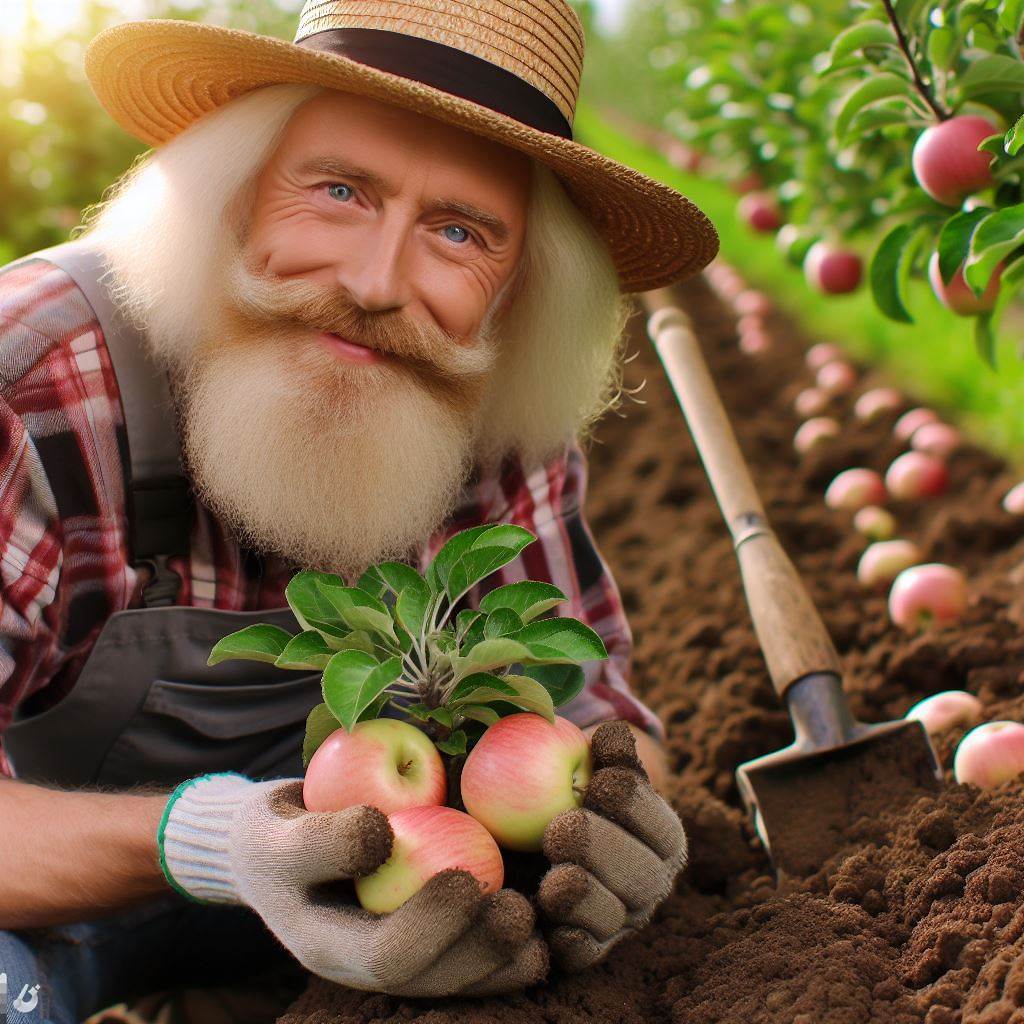The Apple Orchard: Seasons of Hardship
Last Updated on March 1, 2024
Introduction
An apple orchard is a cultivated area specifically for growing apple trees.
Amongst the blossoms of spring, fragile buds burst forth, promising a bounty that foretells both prosperity and struggle.
As summer’s warmth envelops the orchard, the diligent hands of caretakers nurture the burgeoning fruits, while the air resonates with the harmonious hum of nature’s symphony.
Autumn arrives as a painter’s palette, splashing vibrant hues across the landscape, but it also marks the season of challenges — a time when resilience is tested against the impending chill.
The chilling breath of winter sweeps through the orchard, stripping it bare, yet beneath the frost-laden branches lies the silent promise of renewal.
The cycle repeats, an eternal dance between adversity and abundance, shaping not only the orchard’s destiny but also the indomitable spirit of those who call it home.
In “The Apple Orchard: Seasons of Hardship,” we invite you to traverse the winding paths of this arboreal haven, where stories of hardship are etched into the very soil.
Amidst the orchard’s labyrinthine beauty, discover the intricate interplay of seasons and human tenacity, as a resilient community weathers the storms, finding solace and strength in the enduring rhythm of life.
The purpose of this blog post is to explore the hardships that come with maintaining an apple orchard throughout the seasons.
Join us on a journey through the orchard’s seasons, where each hardship becomes a chapter etched in the bark of its storied trees.
Spring Season in the Apple Orchard
Activities Carried Out During Spring
- Preparing the soil by removing weeds and using organic fertilizer.
- Pruning the apple trees to promote healthy growth and improve fruit production.
- Planting new apple trees to expand the orchard and replace old, unproductive ones.
- Managing pests and diseases through regular monitoring and applying necessary treatments.
- Applying appropriate irrigation techniques to ensure the trees get enough water.
- Ensuring proper moisture and temperature levels by mulching the orchard with natural materials.
Challenges Faced by Farmers During Spring
- Unpredictable weather conditions, such as sudden frosts or heavy rains, that can damage the trees.
- Proliferation of pests and diseases, which require constant vigilance and timely intervention.
- Controlling weed growth to prevent competition for nutrients and water.
- Managing labor and resources efficiently during the busy planting and maintenance season.
- Ensuring the availability of necessary equipment and supplies for various orchard activities.
Importance of Spring for the Apple Trees’ Growth and Development
Spring is a crucial period for the growth and development of apple trees, as it sets the stage for the upcoming fruit-bearing season.
Here are some key reasons why spring is essential:
- Bud Break: During spring, the apple trees come out of dormancy and experience bud break, where new buds develop and eventually blossom into flowers.
- Pollination: The blossoming flowers attract bees and other pollinators, facilitating cross-pollination and ensuring fruit set.
- Fruit Formation: After successful pollination, the fertilized flowers develop into small apples, which gradually grow and mature over the season.
- Leaf Development: Spring marks the emergence of new leaves, which play a vital role in photosynthesis, capturing sunlight to produce energy for the tree.
- Root Growth: With the warmer temperature and increased moisture, the apple tree’s root system experiences vigorous growth, strengthening its stability and nutrient absorption capabilities.
- Building Reserves: Spring allows the tree to accumulate energy reserves by converting sunlight, water, and nutrients into carbohydrates that will support future growth and fruit production.
Overall, spring is a busy and critical season in the apple orchard, demanding careful attention and management to ensure the health and productivity of the trees.
Through proper activities, addressing challenges, and leveraging the favorable conditions of spring, farmers can lay a solid foundation for a successful apple harvest in the coming seasons.
Read: From Seeds to Success: An Organic Farmer
Summer Season in the Apple Orchard
Tasks and Responsibilities in the Orchard during Summer
- Pruning trees to ensure proper growth and development.
- Watering trees regularly to prevent drought stress.
- Monitoring pest activity and applying appropriate control measures.
- Fertilizing trees to provide necessary nutrients for healthy growth.
- Trimming weeds and grass around the orchard to minimize competition for resources.
- Inspecting trees for any signs of diseases or infections and taking necessary actions.
- Training young trees to grow in desired shapes and structures.
- Harvesting ripe fruits to maintain orchard productivity.
- Ensuring the overall maintenance and cleanliness of the orchard.
Struggles Faced by Farmers during this Season
Summers in the apple orchard bring along a set of challenges that farmers must address:
- Pests: Insects and pests thrive during this season, attacking the apple trees and damaging the fruits.
- Diseases: The warm and humid weather creates a favorable environment for diseases like apple scab and powdery mildew.
- Drought: A lack of sufficient rainfall can lead to drought, stressing the trees and affecting fruit quality.
- Temperature fluctuations: Extreme temperatures during summer can cause sunburn or heat stress to the delicate apple fruits.
- Heavy storms: Summer storms with strong winds and hail can result in physical damage to the trees and fruits.
Significance of Summer for Apple Tree Pollination and Fruit Formation
Summer plays a crucial role in the pollination and fruit formation process of apple trees:
- The apple tree blossoms attract pollinators like bees, which transfer pollen between flowers.
- Successful pollination leads to fertilization and the development of fruit ovaries.
- During this time, the tree’s energy is devoted to the growth of young fruits.
- Apple fruits gradually enlarge and undergo cell division and expansion.
- The warm temperatures and sunlight aid in the synthesis of sugars and the development of flavor.
- During summer, the fruits also develop their characteristic color and firmness.
- Proper care during this period ensures optimal fruit size, quality, and taste at harvest.
- Summer is a critical phase when the future harvest potential of the apple orchard is determined.
- As the summer heat intensifies, farmers face a challenging time managing their apple orchards.
They diligently perform various tasks, from pruning and watering to pest control and disease prevention.
Insects pose a constant threat, along with diseases that thrive in the warm and humid weather.
The absence of rainfall can lead to drought stress, affecting both the trees and the quality of the fruits.
The warm temperatures and ample sunlight play a pivotal role in the synthesis of sugars, providing the characteristic taste that apple lovers savor.
With careful attention to each tree’s needs and protection from potential threats, farmers strive to secure a bountiful apple harvest.
Summer acts as a critical checkpoint, setting the stage for the orchard’s productivity and the satisfaction of apple enthusiasts in the seasons to come.
Read: Cattle Trails: A Rancher Life and Work

Fall Season in the Apple Orchard
Activities and Preparations during Fall
In the apple orchard during fall, there are several activities and preparations that take place.
- Pruning: Farmers trim and shape the apple trees to promote better growth and increase fruit production.
- Pest Control: Measures are taken to prevent pests and diseases from infesting the apple trees, such as spraying organic pesticides or introducing beneficial insects.
- Fruit Thinning: Excess fruits are removed to ensure that the remaining ones receive enough nutrients and grow to optimal size.
- Irrigation: As the weather becomes cooler and rainfall decreases, farmers continue to provide the apple trees with sufficient water through irrigation systems.
- Fertilization: Nutrient-rich fertilizers are applied to the soil to enhance the growth and productivity of the apple trees.
Hardships Farmers Encounter during Fall
Fall season in the apple orchard also brings various hardships and challenges for farmers.
- Weather Risks: Unpredictable weather conditions, such as early frosts or heavy rain, can damage the apple crop, leading to significant financial losses.
- Labor-Intensive Harvest: Harvesting apples during fall requires a lot of physical labor, as each apple must be carefully picked by hand to avoid any bruising or damage.
- Scarcity of Workers: Finding enough workers during this busy season can be challenging, often leading to increased labor costs and delays in harvesting.
- Equipment Maintenance: Farmers need to ensure that their machinery, such as tractors and harvesters, are in good working condition to efficiently handle the large-scale harvest.
- Storage and Preservation: Proper storage facilities must be prepared to keep the harvested apples fresh and prevent them from spoiling before they reach the market.
Importance of Fall in Harvesting High-Quality Apples
The fall season is crucial for harvesting high-quality apples, and it plays a significant role in the overall success of the apple orchard.
- Ripening Process: Apples reach their peak flavor and sweetness during fall, making it the ideal time to harvest them for the best taste.
- Color Development: Fall weather conditions, with cooler temperatures and shorter daylight hours, contribute to the vibrant color development of apples, making them more visually appealing to consumers.
- Sugar Concentration: As the colder temperatures set in, the apple trees convert more of their starch content into sugars, resulting in sweeter and more flavorful fruit.
- Extended Storage Life: Apples harvested in fall have a longer shelf life compared to those harvested in other seasons, allowing farmers to store and sell them over an extended period.
- Demand and Market Availability: Fall is the peak season for apple consumption, both domestically and internationally, meaning there is a higher demand and better market opportunities for apple farmers.
In general, fall in the apple orchard is a busy and crucial time for farmers.
It involves various activities and preparations, while also presenting challenges and hardships.
Despite the difficulties, fall is essential for harvesting high-quality apples, offering farmers a chance to reap the rewards of their hard work throughout the year.
Read: Grape Expectations: A Vintner Journey
Winter Season in the Apple Orchard
Maintenance and Care for the Apple Trees
During the winter season, apple trees require special attention and care to ensure their health and productivity.
- Pruning: Farmers must prune the apple trees to remove dead or diseased branches and promote new growth.
- Mulching: Applying a layer of mulch around the base of the trees helps to insulate the roots and protect them from extreme cold.
- Watering: Although apple trees need less water during winter, it is still essential to provide adequate moisture to prevent dehydration.
- Pest control: Farmers need to inspect the trees regularly for signs of pests and take necessary measures to control infestations.
Challenges Faced by Farmers
Winter poses various challenges for apple farmers, which can affect the health and survival of their trees.
- Frost damage: Freezing temperatures can cause frost damage to the buds, flowers, and young fruits, leading to reduced yields.
- Pest infestations: Some pests, such as aphids and mites, thrive during winter and can cause significant damage to the apple trees.
- Pruning difficulties: Pruning in winter becomes more challenging as the cold weather makes it uncomfortable and sometimes dangerous for the farmers.
- Limited daylight: Winter days are shorter, providing fewer sunlight hours for the apple trees, affecting their overall growth and development.
Significance of Winter for Apple Trees
Winter is a crucial season for apple trees as it plays a vital role in their dormancy cycle and prepares them for the next year’s crops.
- Dormancy: Apple trees enter a period of dormancy during winter, where their growth slows down, allowing them to conserve energy.
- Cold stratification: Exposing apple seeds to a cold period during winter promotes proper germination and enhances the viability of the seeds.
- Bud development: Winter promotes the development of flower buds in apple trees, ensuring the potential for blossoms and fruit production in the following year.
- Disease control: Cold temperatures during winter help reduce the populations of certain diseases and pests, minimizing their impact on the trees.
In review, the winter season in the apple orchard requires specific maintenance and care for the trees, despite the challenges faced by farmers.
Winter’s significance lies in the trees’ dormancy and the preparation it provides for the upcoming year’s crops.
Understanding and implementing proper winter practices are key to ensuring the health and productivity of apple orchards.
Read: Harvest Tales: Life in the Wheat Fields
Discover More: From City Life to Farm Living: Women’s Tales
Conclusion
Throughout the seasons of the Apple Orchard, we have witnessed the challenges and triumphs faced by apple orchard farmers.
They work tirelessly during spring to cultivate and protect blossoming flowers, then battle the scorching heat of summer to ensure healthy fruit growth.
In autumn, they face the daunting task of harvesting ripe apples, and even in the harsh winter, they continue to care for the orchard.
Each season brings its own hardships, but farmers persevere with unwavering dedication.
Apple orchard farming is no easy task. It requires constant vigilance, hard work, and the ability to adapt to unpredictable weather conditions.
From pest control to ensuring proper irrigation, farmers are tasked with numerous responsibilities throughout the year.
They must rise early, work long hours, and overcome obstacles with determination.
The perseverance and dedication of apple orchard farmers should be recognized and admired.
Next time you bite into a crisp, juicy apple, take a moment to appreciate the efforts of the farmers who made it possible.
The apple orchard farmers work relentlessly to bring high-quality apples to our tables.
Their dedication to producing delicious fruit is the reason we can enjoy the sweet, tangy taste of an apple.
Let us show gratitude and support towards our hardworking farmers who work tirelessly to nourish us with their labor and love.


